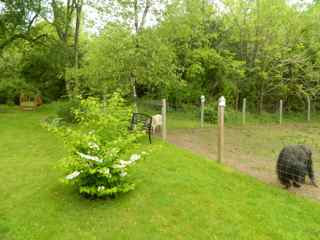We just returned from a fabulous trip to Phoenix, Arizona, where we visited my son and his family. I will be writing about his desert garden soon; so different than mine. As we pulled into our driveway, I was surprised to see my roses are in full bloom, giving a wonderful display of pink, yellow, white and red. I had already decided the rose would be my June signature plant for Diana's meme, Dozen For Diana, but as all my blooms are early, I'm choosing the rose for May instead of for next month.
I have another reason for discussing my roses at this time. I am very nervous that they may be in danger from a virus called rose rosette disease. A few days before our trip, I noticed a very ugly wild rose plant at the edge of the Woodland Walk. On close examination I realized it was infected with the rose-rosette virus.
 |
| Diseased Multiflora Rose |
 |
| Rose Rosette Disease or Witches' Broom |
As I have mentioned several times in this blog, our Woodland Walk is inundated with the invasive multiflora rose. H.H. works hard every year to eliminate it, but there are just too many.
Multiflora rose, introduced as
rootstock for ornamental roses in 1866, grows throughout the U.S. with a
few exceptions, such as the Rocky Mountains. This thorny, perennial
shrub has arching stems and clusters of showy, white-to-pink flowers
that appear in May or June. The rose-rosette virus is spread by a tiny mite and an
infected wasp, and has the
potential to wipe out the multiflora rose, but is a threat to many
ornamental rose species and cultivars also. The symptoms of the rose-rosette disease, sometimes called 'witches' broom',
include elongation of new shoots, distorted/stunted leaves, excessive
thorniness and deformed flowers. Some diseased plants exhibit few of the
symptoms, making diagnosis difficult. An infected plant may die within
two years. The only course of action is to take out all suspected roses in your garden and destroy them
immediately by burning, if allowed in your area, or by bagging and
removing.
I took some of the above information from an article I wrote for eHow. Click here to read more. Dee Nash has also written about this subject on her blog, Red Dirt Ramblings. Dee has lost roses to the disease and is very knowledgeable on the subject, so do visit her blog.
I took some of the above information from an article I wrote for eHow. Click here to read more. Dee Nash has also written about this subject on her blog, Red Dirt Ramblings. Dee has lost roses to the disease and is very knowledgeable on the subject, so do visit her blog.
H.H. took out and burned two infected plants. Now I'm afraid my prized David Austin rose is displaying some of the symptoms and I am watching it carefully. I wrote about my Lichfield Angel, and its origins, here. It would break my heart to destroy it.
None of my other roses are showing a problem at this time.
 |
| Climbing rose Rosa 'Improved Blaze" |
 |
| Climbing rose of unknown species |
 |
| Rosa 'Compassion' and bleeding heart |
 |
| Compassion was chosen for its divine scent |
 |
| Another Knockout rose. |
When we returned from Phoenix this week, I saw the peonies and irises are nearly finished. I'm glad I didn't miss them entirely.
 |
| The peony has exquisite perfume, too. |
 |
| Bearded Iris along Bluebell Creek. The diseased roses were removed from behind them. |
 |
| The strawberries are ripening |
... and not so enjoyable bunnies hopping around it.
Being away, I haven't read your blogs lately, but now I'm off to Diana's amazing garden in South Africa to see more signature plants: do join me at Elephant's Eye.
Wishing you joy in your garden!
Pamela x
 |
| H.H.'s latest bird house. Not yet occupied. |
~~ I love reading your comments. I hope you leave one so I’ll know you visited!
I look forward to visiting your blog in return.














































